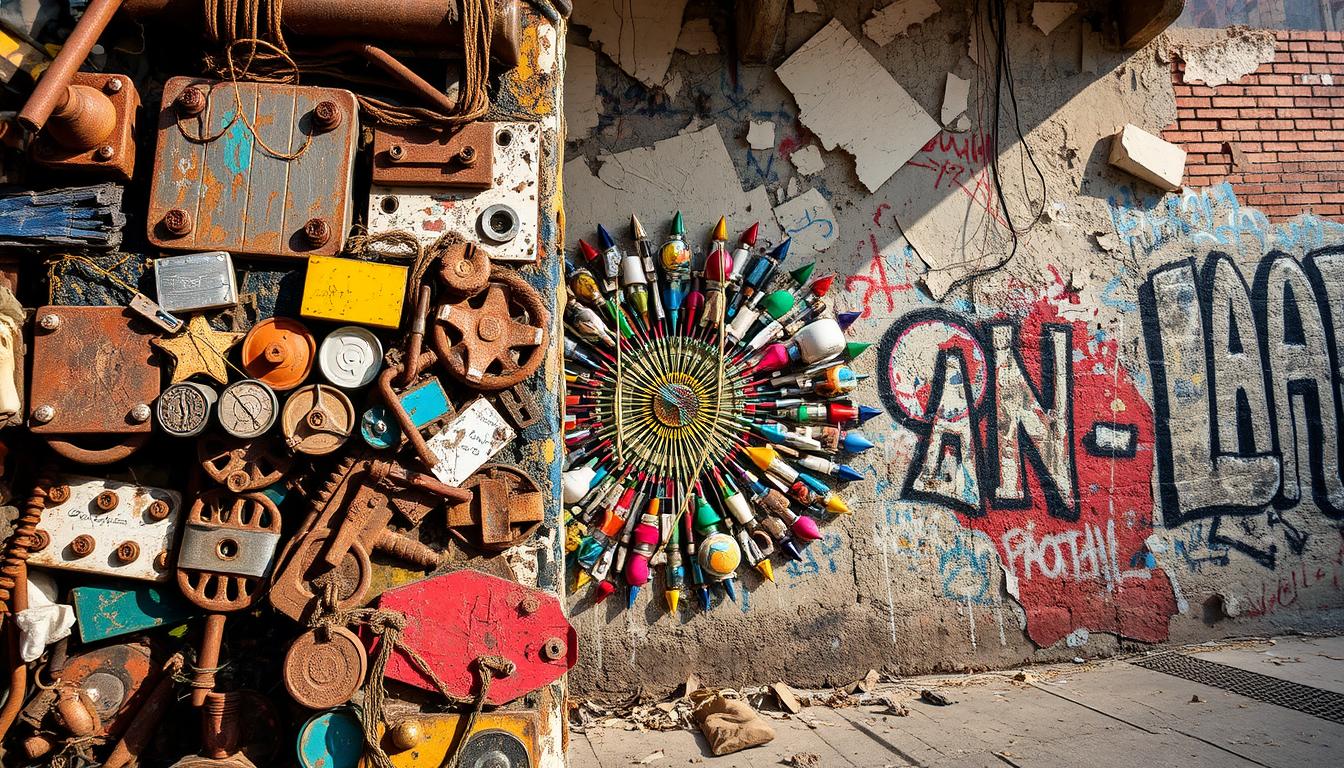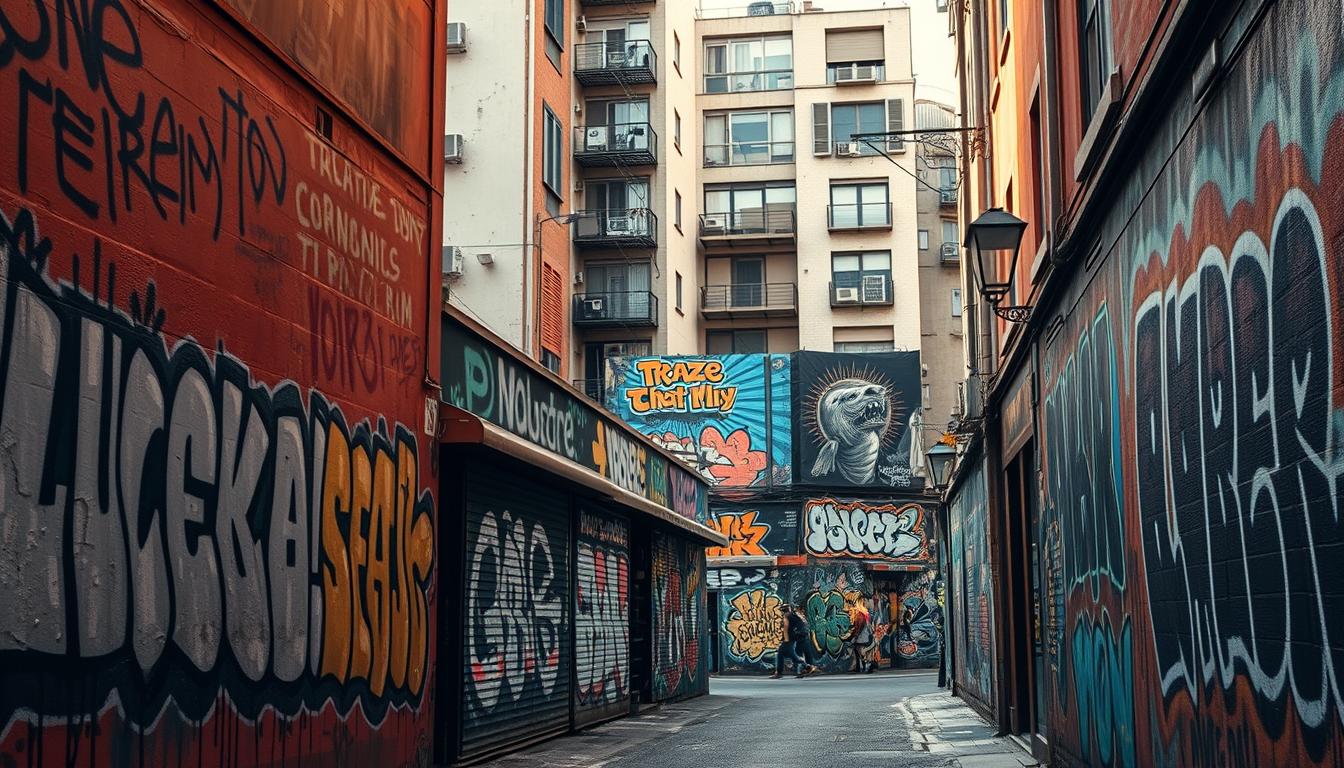Can a painted wall speak for a neighborhood and change how people see a place? This question flips a common belief about galleries and shows how public works reach people where they pass every day.
Murals, graffiti, stencils, sticker pieces and digital projections serve as a living voice for residents. They pull culture out of closed rooms and place it on sidewalks, subway exits and alleyways. That access makes creative work part of daily life.

These urban pieces shape a city's sense of identity. They revive blocks, spark civic talk, and react fast to local events in ways institutions can’t match. Around the world, cities like Miami, Berlin, and New York show how such displays can boost tourism and neighborhood pride.
This article will map how those roles translate into real impact: social change, economic gains, and stronger community ties. Debates will continue, but seeing art on a wall remains a key part of modern public life.
Key Takeaways
- Public works give residents a visible, collective voice.
- These pieces democratize culture beyond galleries.
- They help form local identity and revive neighborhoods.
- Street-based works respond quickly to events and issues.
- Cities that embrace this creativity often gain social and economic benefits.
Defining Street Art in the Urban Landscape
Walls and alleys become forums where visual language meets daily movement. This broad movement covers murals, graffiti, stencils, sticker pieces, wheatpastes and even urban knitting.
Think of it as an umbrella for many public forms that appear on walls and other shared spaces. Some works arrive by commission; others come from lone creators. Both approaches shape how people judge intent and value.
From graffiti to murals: a broad, evolving movement
Scholars still debate neat labels, yet the core aim stays clear: visibility, access, and expression. Many pieces respond to local events and lose meaning if removed from their setting.
Art, vandalism, and the gray areas in public space
Legality varies by place. What one city calls vandalism another treats as public art. That tension feeds civic debate but also keeps urban life dynamic.
"These works live where people live; their meaning grows through interaction."
- Site-specific works belong to their setting.
- Artists and audiences together give pieces ongoing life.
- New forms will keep appearing, inviting experiments on shared streets.
what is the purpose of street art in cities
Color and imagery on buildings create a running conversation across blocks and avenues. This conversation rests on four clear pillars that explain why so many communities welcome public displays.

Freedom of expression and the “voice of the city”
First, these works grant freedom of expression. Artists and people gain a visible channel to speak, protest, celebrate, or mourn where others will see it.
Democratizing art beyond galleries
Public art removes ticket barriers. It moves creative encounters into shared spaces so everyone can engage without planning or cost.
Creating a sense of place and identity
Recurring styles, local themes, and neighborhood murals help communities see themselves reflected. That shared imagery builds a stronger sense and pride.
Responding to local issues with site-specific works
Artists often surface urgent issues—housing, safety, justice—right where those topics matter. Even short-lived pieces can spark long conversations and mobilize neighbors.
"Works placed on common walls meet people where they live, turning daily routes into moments of reflection."
- Expression: a platform for voices.
- Access: art that anyone can encounter.
- Identity: visuals that represent communities.
- Responsiveness: timely reactions to local concerns.
For more on how communities and artists shape this cultural wave, see this local perspective.
Social Impact: Public Art, Protest, and Community Connection
Public displays often give quiet communities a sudden, visible voice. That visibility helps marginalized groups share stories where many can see them.

Amplifying marginalized voices and free speech
One core role is amplification. Public art acts as an open channel for free speech. It lets artists and graffiti artists put urgent messages in plain view.
Raising awareness of social and political issues
Bold pieces spotlight inequality, identity, and the environment. When people pass a vivid mural, they meet local issues on a commute or at a corner.
Community engagement through collaborative murals
Collaborative projects invite residents, youth, and local partners to help paint and plan. That process builds ownership, pride, and trust.
"Painted stories create low-barrier moments where neighbors can reflect, talk, and act."
- Amplify: voices that often go unheard.
- Reflect: artists make issues legible for neighbors.
- Participate: collaborative murals turn making into community work.
Over time, repeated exposure shifts attitudes and inspires civic participation. Small pieces add to a larger tapestry that gives communities real power to connect and respond.
Economic and Cultural Benefits for Neighborhoods and Businesses
A painted corridor can turn a forgotten block into a weekend destination for locals and visitors. That change starts with placemaking: murals and other works give an area a clear identity. Residents feel pride and visitors get reasons to explore.
From murals to magnets: tourism and city attractions
Curated routes and photo-ready walls create attractions that bring tourists and visitors. Guided walks and self-led maps turn local creativity into earned publicity for the whole neighborhood.
Street art as a driver for local businesses
Eye-catching mural faces and storefront artwork make people stop and step inside shops or cafes. Increased foot traffic helps nearby businesses and boosts small business revenue in a natural way.
Revitalizing dull environments into vibrant public spaces
Color transforms neglected blocks into safer, healthier places to walk and linger. Small investments in a mural often spark broader improvements, as owners and residents respond to renewed energy.
"Painted places change perception; activity follows, and with it, business growth and neighborhood pride."
- Placemaking: turning an area into a destination.
- Traffic: murals attract visitors who spend locally.
- Revival: color and care improve environment and safety.
- Collaboration: artists plus business create lasting value.
Real-World Examples That Shaped Cities
Iconic projects show how painted surfaces can pivot entire neighborhoods toward creativity and commerce.
Wynwood Walls, Miami
Founded in 2009 by Tony Goldman, Wynwood Walls turned a run-down area into a major arts destination. Large-scale murals by known artists draw visitors and support a local creative economy.
New York City’s 100 Gates Project
In new york, painted rolling gates beautify storefronts after hours. Over 200 gates reflect local character and help nearby businesses attract customers.
Living Walls, Atlanta
Living Walls pairs artists with residents to address identity, gentrification, and justice. Collaborative murals spark dialogue and build trust across communities.
East Side Gallery, Berlin
A preserved stretch of the Berlin wall became a global symbol. Over 100 murals turn a site of division into shared memory that attracts daily visitors from around the world.
Tour Paris 13 and Los Angeles debate
Tour Paris 13 let many artists transform a 10-story building before demolition, proving cooperative works can redefine a location’s spirit.
In los angeles, authorities separate gang graffiti from commissioned pieces to balance safety and expression. Together, these examples show how murals, graffiti, and public artwork can revive neighborhoods, boost tourism, and deepen civic conversation.
Conclusion
Color on a building can make routine streets feel like shared rooms for a community. This kind of public work brings art into daily life and gives residents a visible voice that invites conversation.
Artists and neighbors often collaborate to shape murals and graffiti that honor history, lift pride, and draw visitors. Many businesses welcome that energy because foot traffic follows lively walls.
Debates about vandalism continue, yet thoughtful projects show how support balances safety with openness. To learn more about how these movements spread and evolve, visit street art movements.
When communities back creative work, they invest in culture, business, and everyday urban life all at once. Go out and see a mural; meet it where it lives.
Enhance Your Space with Unique Modern Masterpieces
Are you inspired by the innovative mediums and conceptual depth highlighted in our exploration of contemporary art? You’re not alone! Today’s art enthusiasts are seeking cultural relevance and emotional connections in their artwork. However, finding pieces that resonate with modern themes and fit your unique style can be a challenge. That’s where we come in!
At Rossetti Art, we specialize in canvas prints, original paintings, and modern sculptures that celebrate the spirit of now. Each piece created by Chiara Rossetti brings a personal touch that connects deeply with current social narratives—just like the modern masterpieces discussed in the article. Don’t miss out on the chance to elevate your home decor with breathtaking artwork that speaks to your values and aesthetic. Explore our collection today and find your perfect piece! Act now, and transform your space into a gallery of inspiration!
FAQ
Why does street art matter in modern cities?
It brings color, culture, and conversation to public spaces. Murals and graffiti transform blank walls into landmarks, attract visitors, and help neighborhoods tell their stories. That visual energy often boosts nearby businesses and encourages community pride.
How do experts define graffiti versus murals?
Graffiti often refers to tags and lettering rooted in subculture, while murals are planned, large-scale works by artists such as Shepard Fairey or Kobra. Both belong to a wider public-art movement that keeps evolving as artists experiment with materials, styles, and messages.
Where does the line fall between art and vandalism?
The line depends on permission and context. Commissioned murals and sanctioned projects celebrate creativity, while unsanctioned tagging can be seen as property damage. Cities like Los Angeles and New York balance enforcement with programs that redirect artists into legal channels.
How does street art serve as a voice for communities?
Artists highlight local stories, cultural heritage, and social concerns. Murals by community members or collectives amplify perspectives often absent in galleries, giving residents a visible platform for identity and change.
Can public murals really improve safety or neighborhood feel?
Yes. Thoughtful art activates neglected spaces, reduces graffiti by replacing blank surfaces, and signals investment. Projects like Wynwood Walls show how concentrated murals make areas feel safer and more welcoming to visitors and residents alike.
Do murals help local businesses and tourism?
Absolutely. Street-art districts draw foot traffic, create photo-friendly destinations, and lengthen visitor stays. Many small businesses thrive when neighborhoods become cultural attractions, increasing sales and neighborhood visibility.
How do artists respond to local issues through site-specific works?
Artists study a location, its history, and its people, then create pieces that speak directly to that context. Living Walls in Atlanta and community murals often address housing, justice, and identity, prompting dialogue and empathy.
How do cities support collaborative mural projects?
Cities fund artist residencies, grant programs, and wall-permit initiatives. Partnerships with businesses, nonprofits, and residents help secure walls and materials while ensuring works reflect community needs and values.
Are there notable examples where murals reshaped entire neighborhoods?
Yes. Wynwood in Miami turned from warehouses into an arts hub. New York’s 100 Gates Project brightened storefronts across boroughs. Berlin’s East Side Gallery reinterpreted a historic barrier as collective memory through art.
How do murals amplify marginalized voices and free speech?
Murals offer a public stage for artists from underrepresented backgrounds. Projects often center narratives about race, migration, and labor, making those stories visible to residents and visitors and advancing civic conversation.
What role do tourists and visitors play in street-art ecosystems?
Visitors bring economic value and attention. Photo tourism can fund local guides, tours, and small businesses. Responsible visitation, however, should respect neighborhoods and support local creators rather than exploit their work.
How can residents balance preservation with evolving murals?
Open dialogue helps. Communities set guidelines for maintenance, temporary works, and commissioned replacements. Collaboration between artists, property owners, and preservation groups keeps murals relevant while honoring original intent.






Leave a comment
This site is protected by hCaptcha and the hCaptcha Privacy Policy and Terms of Service apply.